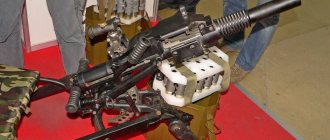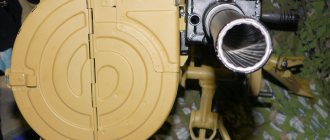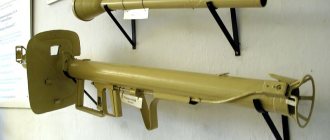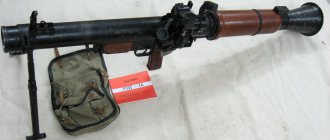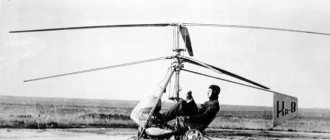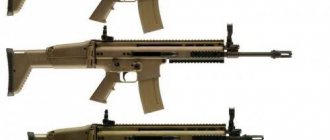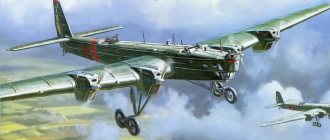AGS-17 “Plamya” is a Soviet easel automatic grenade launcher, which was developed at OKB-16 (now the Nudelman Design Bureau), and put into service in 1970. It is intended to destroy enemy infantry located both openly and behind natural folds of the terrain (on the reverse slopes of heights, in ravines, hollows), as well as in open field fortifications (trenches, rifle cells). The caliber of the AGS-17 grenade launcher is 30 mm.
The AGS-17 “Plamya” mounted grenade launcher is a powerful anti-personnel weapon with excellent tactical and technical characteristics. It can hit the enemy with both overhead and flat fire. The grenade launcher is still in service with the Russian army, in addition, the AGS-17 is used in the armed forces of another two dozen countries around the world (former Soviet republics, China, Iran, India, Finland, North Korea and others).
The strengths of the AGS-17 are its simplicity, reliability and versatility - the grenade launcher can be used not only from the machine, but also installed on various types of military equipment, including helicopters.
AGS-17 “Flame” is a formidable and effective weapon, proven in dozens of conflicts. Afghanistan became his baptism of fire. This grenade launcher has proven itself well during combat operations in the mountains. The AGS-17 was “respected” not only by Soviet soldiers, the Mujahideen also used captured examples of this weapon with great pleasure. The AGS-17 went through the first and second Chechen campaigns and other local conflicts that broke out in the territory of the former Soviet Union; the grenade launcher is currently actively used in Syria.
Serial production of the AGS-17 automatic grenade launcher was launched at the machine-building plant; currently there are several modifications of this weapon. In addition, the AGS-17 was produced in China and the former Yugoslavia.
History of creation
The first automatic grenade launcher AG-TB was developed in the USSR by the talented gunsmith designer Taubin in the early 30s of the last century. The idea of combining the rate of fire of automatic weapons with the damaging effect of fragmentation ammunition seemed very successful. The new type of weapon interested the military, prototypes were made and tests were carried out.
The AG-TB grenade launcher even managed to take part in the Winter War. There were plans to install new weapons on combat boats, aircraft, and armored vehicles. But, in the end, the 50-mm Shavyrin mortar was adopted, and work on automatic grenade launchers was stopped.
True, thanks to the AG-TB project, OKB-16 appeared, headed by Yakov Taubin.
For a long time in the USSR, automatic grenade launchers were not given due attention. Only after the Americans successfully began using the Mk 19 automatic mounted grenade launcher in Vietnam did the Soviet military think about creating an analogue.
The development of the grenade launcher was entrusted to the same OKB-16, however, at that time it was no longer led by Taubin, but by his student and follower Nudelman. The project was headed by Alexander Fedorovich Kornyakov.
In 1967, a firing model of the weapon was ready, it was called AGS-17. After some modifications and testing, in 1971 the Soviet army adopted a new type of small arms.
It should be noted that, structurally and according to the classification established in the Soviet Union, the AGS-17 “Plamya” is a small-caliber automatic weapon. Accordingly, his shot is a small-caliber artillery cartridge with a high-explosive fragmentation projectile. The name of the weapon (“automatic grenade launcher”) is more related to the tactical tasks it performs on the battlefield and is not determined by its design. Together with under-barrel launchers, automatic grenade launchers formed a new class of weapons - “support weapons.”
In combat conditions, the AGS-17 was used for the first time during the Vietnamese-Chinese conflict in 1979. The real test for this weapon was the war in Afghanistan, and it must be said that the AGS-17 passed it brilliantly. There were often cases when they independently welded “Plamya” grenade launchers to the body of armored vehicles, significantly increasing its combat power.
The first modifications of the weapon had a barrel with an aluminum radiator for cooling; later, fins on the outer surface of the barrel began to perform its functions.
CONTENT:
- Automatic grenade launcher on the AGS-17 Flame machine
- Automatic grenade launcher on the AGS 30 machine
- Automatic mounted grenade launcher AGS-40 Balkan
The ammunition for it was developed on the basis of the standard Dyakonov rifle grenade. Despite the novelty and demand for this type of weapon, the Ag-2 could not get a start in life.
The reason was the technical imperfection of the product and the complexity of production (special grades of steel and many milled parts). Nevertheless, the idea of such a weapon, capable of targeting infantry at ranges exceeding 1 km, was in the minds of military personnel and designers. And it had to be implemented urgently after the successful creation and use in the Vietnam War of the AGS Mk.19 mod.1 and mod.2, created by the Americans. These grenade launchers were far from ideal, but caused damage to Viet Cong units.
The idea of combining the high rate of fire and lethality of hand grenades was embodied in the AGS-17 automatic grenade launcher.
Description of design
The AGS-17 automatic system works by rolling back the free shutter. The use of such a scheme allows the short barrel length, weak propellant charge of the grenade and low muzzle energy of the ammunition. The design of a grenade launcher consists of the following elements: trigger mechanism, receiver, box with barrel, bolt, reloading mechanism, return springs.
AGS-17 has a rifled barrel that can be quickly replaced; it is attached to the receiver using a pin and a lock. The rectangular bolt of the grenade launcher is equipped with a rammer, which moves vertically, and a comb that removes the spent cartridge case. Inside the bolt there is a hydraulic recoil brake, which increases the automatic cycle, thereby increasing the accuracy and accuracy of fire. The brake consists of a cylinder with kerosene, a rod with a piston and a flange that prevents fluid from leaking out. When recoiling, the hydraulic brake rests against the butt plate of the weapon, and when moving forward, against special protrusions of the receiver.
There are two return springs in the shutter channel.
The AGS-17 receiver cover contains a reloading mechanism, consisting of a clip and a cable with a T-shaped handle. When the cable is pulled, the bolt is pulled back. When firing from the AGS-17, the reloading mechanism remains motionless.
The impact mechanism of the easel grenade launcher is of the trigger type. During the descent, the trigger hits the firing pin lever located in the bolt. The trigger mechanism is located on the left side of the receiver.
AGS-17 is equipped with a flag-type fuse that locks the trigger sear. The grenade launcher has a mechanism for adjusting the rate of fire. It works by changing the duration of the weapon's automatic operation cycle.
The flag, with which you can change the rate of fire, has two fixed positions: top – 350-400 rounds/min. and lower - 50-100 shots/min. To control the AGS-17 grenade launcher, two horizontal folding handles are used, with a trigger lever located between them.
The AGS-17 has a belt feed; the grenade launcher’s belt is a link, metal, with an open link. It fits into a round-shaped box, which is attached to the right side of the receiver. The tape feeding mechanism consists of a spring-loaded feeder and a feed lever with a roller. The used cartridge case is extracted from the receiver using a special reflector downwards.
The shooting tape is loaded either manually or using a special machine. The box holds a standard 29 shot belt. The tape capacity is 30 shots, but it does not have a shank, so its role is played by the outermost link, which is inserted into the receiver.
The tape box has a carrying handle, a lid and a flap with latches, as well as a special curtain that closes the neck during transportation.
To aim the weapon, the PAG-17 optical sight is used, which is installed using a bracket on the left side of the receiver. Sights allow direct fire at a distance of 700 meters, and they can also be used when firing from closed positions. In addition to the optical one, the grenade launcher is also equipped with a mechanical sight, which consists of a front sight and rear sight.
To install AGS-17, the SAG-17 machine is used. In the stowed position, the SAG-17 folds and is usually moved by the second crew number. All machine supports are adjustable, which makes the use of the grenade launcher convenient in any situation.
For firing, the AGS-17 can use several types of shots, the most commonly used are VOG-17 and VOG-17M. Each of these shots consists of a cartridge case, a powder charge, a grenade and a flash fuze. The grenade has a thin-walled body with a notched wire of rectangular cross-section laid inside. After the primer is pierced, the powder charge in the cartridge case ignites and a shot occurs. The fuse is armed only after 50-100 meters of flight, which ensures the safety of the crew.
VOG-17M is a modernized grenade equipped with a self-destruct mechanism. In addition to combat shots, the grenade launcher's ammunition can also include practical shots. For example, VUS-17, which instead of an explosive contains a pyrotechnic composition that produces orange smoke at the impact site. Training ammunition has also been created for the AGS-17.
Shots for the AGS-17 grenade launcher were developed at NPO Basalt. Several more types of ammunition were created by foreign companies.
Sights
The AGS-17 manual includes instructions for using, in addition to the main mechanical sight, also the PAG-17 prismatic optical sight. In the case of direct fire at distances of up to 700 meters, it is easier for the crew to do without optics. PAG-17 is needed for firing from closed positions or at distant targets. Its design allows it to also be used as a range finder if the dimensions of the object are known. The lens is equipped with light filters, there are two of them. One has a neutral color and slightly reduces the light intensity in sunny weather, the other is designed for aiming at dusk and is made using a brightening orange optical layer. The sighting marks are applied in the form of corners and strokes, with division values of 100 and 50 meters, respectively. On the sides of the central crosshair there are lateral correction icons. Electric illumination for night mode is equipped with batteries.
Modifications
Currently, there are several modifications of the AGS-17:
- AGS-17 "Flame". This is a basic modification of the weapon, which is installed on the SAG-17 tripod machine.
- AP-30 "Flame-A". An aviation modification of the grenade launcher, developed in 1980. This option differs from the basic one in the presence of an electric trigger, a shot counter, a slightly reduced rifling pitch in the barrel and a higher rate of fire. Accordingly, the AP-30 had to be equipped with a more massive barrel cooling radiator. This version of the grenade launcher was usually placed in a special hanging container.
- AG-17D. Modification installed on the Terminator infantry support fighting vehicle
- AG-17M. The marine version of the grenade launcher, which is intended for installation on boats, is also used on the BMP-3.
- KBA-117. A modification of the grenade launcher developed by Ukrainian designers from the Artillery Armament Design Bureau. It is part of the combat modules of armored vehicles and armored boats.
Automatic mounted grenade launcher AGS-40 Balkan
The new AGS - 40 turned out to be heavy - 32 kg. This is the price for a high rate of fire - 400 rounds per minute and a range of -2500 meters. For comparison, the American Mk-47 has a firing range of 2200 meters and is capable of firing 250-300 rounds per minute. And this with a weight of 40 kg.
Given the approximately comparable power of the ammunition, the score is in favor of Russian developers. The disadvantages include the lack of remotely detonated ammunition. But work is underway on it and it’s only a matter of time.
New developments by gunsmiths made it possible to simplify the design of the Balkan. The AGS consists of a 400 mm long barrel and a receiver. Next to the breech there is a casing for the shot feed system. In the rear there are fire control handles with a trigger. On the right there is a reload lever. Inside the receiver there is the bolt itself, the return spring and the bolt group. Automation is based on the use of powder gas energy.
The main ammunition of the AGS-40 Balkans is 7P39. Magazine box capacity 20 shots. The design of the shot is caseless, similar to the VOG-25 for grenade launchers. The cartridge case flies away along with the shot and participates in the formation of a fragmentation field. It should be noted that the Ags-40 with automatic fire provides a high density of fire damage. In this case, recharging takes several seconds.
Exploitation
The AGS-17 crew consists of two people; the crew may also include an ammunition carrier. As a rule, shooting is carried out in automatic mode, although single fire can also be fired. The most effective is firing in short bursts (3-5 grenades).
In combat, the grenade launcher is moved together with the machine; for this, you can use special belts. It should be noted that this weapon weighs a lot - 18 kg, and together with the machine - 52 kg. And this is not counting the ammunition of the grenade launcher. This fact can be called the main disadvantage of the grenade launcher. In general, we can say that the AGS-17 is a reliable and effective weapon that is quite easy to operate. Its disassembly does not require additional tools and can be carried out in the field. All of the above qualities have been repeatedly tested during many wars and conflicts of recent decades. In most of its characteristics, the AGS-17 confidently surpasses its foreign analogues.
Automatic grenade launcher on the AGS 30 machine
This model replaced the already obsolete AGS 17. The new grenade launcher was put into service in 1995. Reduced dimensions and weight up to 16.5 kg made it more mobile and effective in real combat. The crew could have taken more ammunition. And the assembled AGS-30 could carry one calculation number.
Small dimensions and a special, improved design of the tripod provided greater mobility and the ability to quickly change positions. At the same time, the unification of ammunition is ensured. The AGS30 can fire both the old VOG-17 and the VOG-30 specially developed for it.
The new VOG-30 ammunition deserves special attention - a new production technology was used here. The cold deformation method made it possible to obtain a set of semi-finished fragments with sharp edges. This made it possible to strengthen the fragmentation field and increase its power by 1.5 times.
One shot of VOG 30 weighing 350 g. allows you to hit an area of 10 by 10 m. And a specially designed high-explosive fragmentation round GPD-30 covers an area of 130 m2. At the same time, the problem of defeating personnel wearing personal protective equipment - body armor and helmets up to class 3 - has been solved.
Another advantage of the AGS-30 is its increased firing range to 2200 m. The predecessor fired only at 1700 m. This was achieved by reducing the drag of the projectile in flight, and not by increasing the powder charge and, accordingly, altering the weapon mechanics. At the same time, the accuracy of fire increased.
The grenade is cocked into firing position at a distance of 30-60 meters after the shot. This allows the AGS-30 crew to not be damaged in case of abnormal operation of the fuse. The instantaneous fuse provides a guaranteed detonation upon contact with any surface - loose snow, water.
Performance characteristics of AGS-30:
Caliber – 30 mm. Grenade – 30x29 mm. Overall dimensions (with a tripod machine) – 1165x735x490 mm. Weight without cartridge box and sight - 16.5 kg. Rate of fire – up to 400 rounds/min. The initial speed of the grenade is 185 m/s. The capacity of the cartridge box is 30 shots. Sighting range - up to 1700 m (VOG-17, VOG-17M and VOG-30 rounds), up to 2200 m (GPD-30 rounds). Calculation - two people.
Good combat characteristics allow the AGS-30 to remain in service to this day. But we must not forget that the standard shot for AGS in NATO is a 40X53 mm grenade, that is, 40 and not 30 mm caliber.
And now the time has come for a more modern and powerful installation.
Characteristics
Below are the performance characteristics of the AGS-17.
| Caliber, mm | 30 |
| Barrel length, mm | 290 |
| Total length, mm | 840 |
| Total weight, kg | 18 |
| Weight with machine, kg | 52 |
| Rate of fire, rds/min | 65 |
| Radius of continuous damage, m | 7 |
| Rate of fire, rds/min | 100 |
| Initial speed of the grenade, m/s | 120 |
| Combat crew, people | 2-3 |
| Sighting range, m | 1700 |
TTX AGS-17
The AGS-17 grenade launcher has the following tactical and technical characteristics :
- Caliber AGS-17 - 30 mm
- Weight AGS-17 - Grenade launcher with mounting and sight - 31 kg - Body: 18 kg - Boxes with grenades: 14.5 kg
- Dimensions AGS-17 - Length, mm: 840 mm - Barrel length, mm: 305 mm
- The rate of fire of the AGS-17 is 50-100 (single); 350—400 (bursts) rounds/min
- AGS-17 projectile speed - 185 m/s
- Sighting range of AGS-17 - 1700 meters
- Crew (crew), people: 2 – 3
- Projectile: 30x29 mm
AGS-17 “Flame” was distributed throughout the planet in huge quantities. This model was in service with the armies of most post-Soviet countries, as well as the DPRK, India, Serbia, Cuba, Iran, Finland and other countries. The successor to the famous automatic grenade launcher is the Russian second generation automatic grenade launcher AGS-30.
Average ammunition consumption to defeat single and group targets (after zeroing)
| Range m | Single target | Group target on the square | ||||
| suppress | destroy | 30x50 m | 100x50 m | |||
| suppress | destroy | suppress | destroy | |||
| 400 | 4 | 6 | 29/- | 91/- | 91/- | 308/- |
| 600 | 6 | 9 | 33/- | 109/- | 114/- | 362/- |
| 800 | 8 | 12 | 42/- | 133/- | 139/- | 438/- |
| 1000 | 10 | 16 | 54/30 | 170/94 | 176/70 | 557/258 |
| 1200 | 12 | 19 | 60/34 | 191/107 | 194/81 | 612/258 |
| 1400 | 13 | 21 | 60/36 | 192/114 | 190/92 | 600/290 |
| 1600 | 15 | 24 | 57/45 | 184/142 | 175/116 | 553/368 |
Notes: 1. When calculating the average ammunition consumption, the following probability of hitting a target was adopted: for suppression - 50%, for destruction - 80%; a single target is a machine gun (grenade launcher) with a crew at a front of 4 m, a group target includes 50% running and chest figures.
2. The numerator indicates the consumption of ammunition when firing with a flat trajectory, and the denominator indicates the consumption of ammunition when firing with a mounted trajectory.
Peculiarities
AGS-17 in its class belongs to a small-caliber automatic gun. It fires small-caliber artillery charges filled with high-explosive fragmentation. The name of a weapon is more related to its tactical tasks rather than its design features. Together with under-barrel analogues, the modification in question formed a new category - support weapons.
The first baptism of fire of the grenade launcher took place during the Vietnamese-Chinese conflict, and the real test was the war in Afghanistan, where the weapon showed itself exclusively on the positive side. The first versions were equipped with a barrel with an aluminum cooling radiator, and later models were equipped with fins on the outer working surface.
Just five shots
In motorized rifle (motorized infantry) and airborne squads, single-shot rifled anti-personnel grenade launchers are successfully used - mainly in the form of under-barrel grenade launchers. Their disadvantage is their limited range and low rate of fire. Even the Soviet GP-25 and GP-30 with their ingenious muzzle-loading circuitry allow firing no more than 5 rounds per minute. Meanwhile, back in the late 1930s, at the Ya.G. Taubin developed an automatic 40.8-mm grenade launcher, which was not accepted for service at that time. Taubin's successor A.E. Nudelman “returned to the topic” thirty years later. A definite incentive was the attempts of the Americans to use their experienced automatic grenade launchers in Vietnam to support infantry and arm patrol boats. In 1971, in the USSR, under the designation AG-17 (in the easel version - AGS-17), the “flame” was adopted into service with a 30-mm automatic grenade launcher, created in the design bureau of A.E. Nudelman. The ability to conduct flat and mounted fire with fragmentation grenades and an effective firing range of up to 1,200 m give the automatic grenade launcher the qualities of a short-barreled “infantry gun” and a light mortar. The Americans, although they used experimental grenade launchers earlier than others, officially adopted their 40-mm Mk19 into service ten years later than the AGS-17. The AGS-17 experienced its baptism of fire in Afghanistan and earned the trust of soldiers. In the mountains it was often the only fire support the unit could carry. Among the first generation automatic grenade launchers, it became one of the lightest. A good effect was achieved by combining its mounted fire with the flat fire of heavy machine guns. In Chechnya, Dagestan, and other “hot spots”, AGS-17 has confirmed its effectiveness.
The 30-mm AGS-30 grenade launcher, created by the Tula Instrument Design Bureau, not only turned out to be simpler and lighter (this second-generation grenade launcher along with the machine can be carried by one person), but also received a shot with better ballistics and fragmentation effect. The growing world interest in automatic grenade launchers (their models are produced in Spain, China, Singapore, and South Africa) indicates the promise of this type of weapon.
Trenches for grenade launcher
(Fig. 56, 57)
The trench consists of a platform for installing a grenade launcher, a ditch for placing the crew, a platform for ammunition and a parapet. A communication passage is provided to the trench.
By moving the grenade launcher from one site to another, you can expand the firing sector to 100-120°. The adopted depth (90 cm) ensures firing from a grenade launcher from a standing position. The shape and dimensions of the trench make it possible to place the assembled grenade launcher at the bottom of the trench.
When setting up trenches in soft soils, it is necessary to provide clothing for steep platforms for installing a grenade launcher from poles with a diameter of 5-7 cm.
The scope of work and material consumption for constructing trenches with one and two platforms are shown in the following table.
Rice. 56. Trench with one platform
Rice. 57. Trench with two platforms
Other nodes and elements
The receiver cover has a reloading mechanism, which includes a clip, a cable and a handle in the shape of the letter “T”. The bolt is retracted when the cable is pulled back. When firing from the AGS-17, the reloading unit remains stationary.
The striking part is of the trigger type. During the descent, the lever of the striker located in the bolt is affected. The trigger mechanism is located on the left side of the receiver. The grenade launcher has a safety lever that locks the sear. There is also a mechanism for adjusting the rate of fire; its functionality depends on the duration of the gun’s automation cycle. The upper fixed position is up to 400 shots, the lower position is up to 100 salvos (per minute).
The weapon is controlled by a pair of horizontal folding handles, between which the trigger lever is located. The grenade launcher's feed belt is metal with open links. It is placed in a round box mounted on the right side of the receiver. The feed mechanism includes a spring-loaded rammer and a lever with a roller. The used tape is removed from the seat downwards using a special reflector.
The magazine carrying box has a handle, a lid, a flap with latches, and a special curtain designed to mask the neck during transportation. The shot tape can be loaded manually or using a special machine. A 30-link magazine with cartridges is placed in the box, the outermost one is inserted into the receiver and plays the role of a shank.
Device and principle of operation
The AGS-17 grenade launcher operates by rolling back the free bolt. When fired, the powder gases act on the bottom of the cartridge case, throwing the bolt to the rearmost position. As a result, the return springs are compressed, the next charge is supplied to the delivery line to the input window, as well as the subsequent reflection of the spent element. When the bolt rolls forward, ammunition is delivered to the chamber and the firing pin is cocked. At the moment the locking part reaches the extreme frontal position, the bolt is disconnected from the firing pin. Moved back under the pressure of the mainspring, it hits the firing pin lever. The igniter primer heats up and a shot occurs.
The design of AGS-17 includes the following elements:
- trigger mechanism;
- receiver;
- recharging unit;
- receiver;
- return springs.
The grenade launcher is equipped with a rifled quick-change barrel, which is fixed on the box with a lock and pin. The rectangular bolt has a rammer that moves vertically, as well as a comb that serves to remove the spent cartridge case.
A hydraulic recoil brake is located in the inner part of the bolt. It optimizes automation, increasing the accuracy and accuracy of fire. This unit includes a rod with a piston, a cylinder filled with kerosene and a flange to prevent liquid leakage. When rolling back, the brake block locks on the butt plate, and when moving forward, it rests against special protrusions of the receiver.
Yugoslav and Soviet AGS
The performance characteristics of the AGS-17 of Soviet and Yugoslav (licensed) production are somewhat different, although not significantly. The caliber and ammunition are completely unified (30 x 29 B). The barrel of the grenade launcher produced in the SFRY is longer (305 versus 290 mm), which explains the high initial velocity of the projectile (185 and 120 m/s, respectively). The Yugoslav's rate of fire is much higher (400 rounds/min), but this advantage does not always please the soldiers, especially in conditions where ammunition needs to be conserved. The sighting range of both samples is the same and is 1700 m. The minimum distance to the target is 1000 m.

